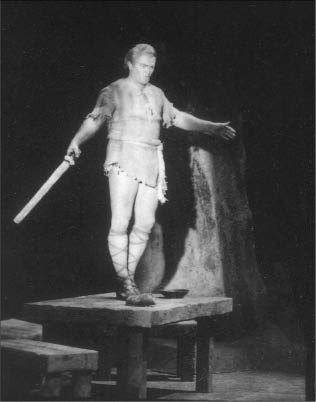Those Wacky Wagnerites

If there’s one thing I’ve learned about people who love the operas of Richard Wagner it’s that you can never be completely sure of what will please them. Wagnerites are what we call a “special breed.” Maybe it has something to do with the sheer magnitude of the operas: they’re deep like the Himalayas are tall, and the air gets pretty rarefied. The very first time I directed a Wagner opera I showed Wagnerites something they’d never seen before. And come to think of it I don’t think it’s been done since.
The opera was Die Walküre, the year 1963, and the place San Francisco Opera. At the time the company didn’t employ lighting designers: stage directors were expected to create lighting plots on their own. My understanding of lighting in those days could be described as dim, so I hit up the chief lighting designer at Bayreuth for some lessons. Armed with this knowledge I made what I thought was an appropriate plot. And feeling emboldened by my study at Bayreuth — no less than the wellspring of all things Wagner — I decided to add a flourish.
One of Die Walküre’s primary symbols is a sword stuck in a tree that can be removed only by a great hero, and a unique musical motif refers to the sword at critical moments. I came up with a clever bit of lighting. The set featured a hearth that could glow realistically, and so whenever the motif was heard I cued it to flare up, which in turn cued a special

Jon Vickers in Die Walküre at San Francisco Opera, 1963.
Photo by Carolyn Mason Jones.
spotlight focused tightly on the sword. Quite contrastive with the set, it clearly stood out. I thought I was being brilliant.
Our hero, Siegmund, was played by the great heldentenor Jon Vickers. Everything went fine in rehearsal: the motif would sound, the hearth would illuminate brightly, and the sword would glow eerily. But by opening night somehow the special spotlight had become loose. As the capacity crowd watched, Jon bounded onto a platform near the tree, grabbed the sword, and sang out “Wälse,” initiating the clarion phrase of this pivotal moment. As he did so the loosened special light began to go askew. From my vantage point at the back of the theatre I could see something was wrong. The light pool that I was so proud of was slowly inching lower and sideways. First it scanned across Jon’s arm, then his torso. My heart began to sink as I saw my artistic handiwork being compromised. I didn’t have a lot of time to dwell on it, though, when I saw where the light landed. When my tightly focused, special amber spotlight came to a halt, it perfectly outlined Jon Vickers’s crotch. Even the people in the balcony couldn’t have missed it. And Jon could hold out these difficult notes forever, maintaining an unflinching, statue-like posture. In other words, he stood stock-still delivering the vocal goods while his other goods were highlighted as bright as day.
Mortified, I rushed to the downstairs bar and ordered a double scotch. I could only imagine what the rabid fans in the house would have to say to me. Sure enough, during the intermission a crowd of die-hard Wagnerites cornered me — to shower me with compliments. They thought that the lighting was purposeful, a symbolic uniting of the magical sword and Siegmund’s phallus, a profound comment on the nature of mortality, masculinity, the id versus the superego, blah, blah, blah. In complete seriousness one congratulated me on the “brilliant, psychologically adept” lighting. Speechless, I could only nod.
Incidentally, Jon had no idea that it had happened.